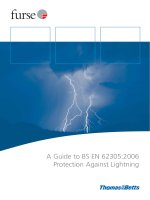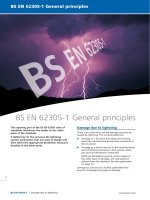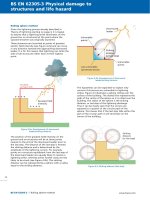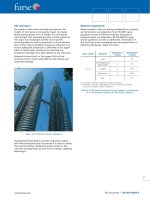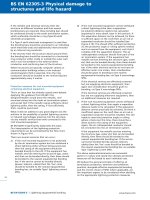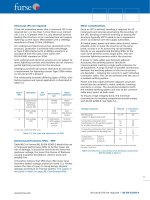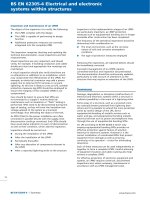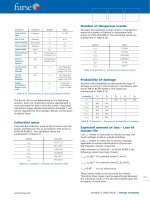Bsi bs en 00643 2014
Bạn đang xem bản rút gọn của tài liệu. Xem và tải ngay bản đầy đủ của tài liệu tại đây (1018.04 KB, 20 trang )
BS EN 643:2014
BSI Standards Publication
Paper and board — European
list of standard grades of paper
and board for recycling
BS EN 643:2014
BRITISH STANDARD
National foreword
This British Standard is the UK implementation of EN 643:2014. It
supersedes BS EN 643:2002 which is withdrawn.
The UK participation in its preparation was entrusted to Technical
Committee PAI/11, Methods of test for paper, board and pulps.
A list of organizations represented on this committee can be
obtained on request to its secretary.
This publication does not purport to include all the necessary
provisions of a contract. Users are responsible for its correct
application.
© The British Standards Institution 2014. Published by BSI Standards
Limited 2014
ISBN 978 0 580 79419 3
ICS 85.060
Compliance with a British Standard cannot confer immunity from
legal obligations.
This British Standard was published under the authority of the
Standards Policy and Strategy Committee on 31 January 2014.
Amendments issued since publication
Date
Text affected
BS EN 643:2014
EN 643
EUROPEAN STANDARD
NORME EUROPÉENNE
EUROPÄISCHE NORM
January 2014
ICS 85.060
Supersedes EN 643:2001
English Version
Paper and board - European list of standard grades of paper and
board for recycling
Papiers et cartons - Liste européenne des sortes standard
de papiers et cartons pour recyclage
Papier, Karton und Pappe - Europäische Liste der
Altpapier-Standardsorten
This European Standard was approved by CEN on 6 December 2013.
CEN members are bound to comply with the CEN/CENELEC Internal Regulations which stipulate the conditions for giving this European
Standard the status of a national standard without any alteration. Up-to-date lists and bibliographical references concerning such national
standards may be obtained on application to the CEN-CENELEC Management Centre or to any CEN member.
This European Standard exists in three official versions (English, French, German). A version in any other language made by translation
under the responsibility of a CEN member into its own language and notified to the CEN-CENELEC Management Centre has the same
status as the official versions.
CEN members are the national standards bodies of Austria, Belgium, Bulgaria, Croatia, Cyprus, Czech Republic, Denmark, Estonia,
Finland, Former Yugoslav Republic of Macedonia, France, Germany, Greece, Hungary, Iceland, Ireland, Italy, Latvia, Lithuania,
Luxembourg, Malta, Netherlands, Norway, Poland, Portugal, Romania, Slovakia, Slovenia, Spain, Sweden, Switzerland, Turkey and United
Kingdom.
EUROPEAN COMMITTEE FOR STANDARDIZATION
COMITÉ EUROPÉEN DE NORMALISATION
EUROPÄISCHES KOMITEE FÜR NORMUNG
CEN-CENELEC Management Centre: Avenue Marnix 17, B-1000 Brussels
© 2014 CEN
All rights of exploitation in any form and by any means reserved
worldwide for CEN national Members.
Ref. No. EN 643:2014 E
BS EN 643:2014
EN 643:2014 (E)
Contents
Page
Foreword ..............................................................................................................................................................3
Introduction .........................................................................................................................................................4
1
Scope ......................................................................................................................................................5
2
Terms and definitions ...........................................................................................................................5
3
Group classification ..............................................................................................................................6
4
Grade identification ...............................................................................................................................6
5
5.1
5.2
5.3
5.4
5.5
5.6
5.6.1
5.6.2
5.6.3
General requirements ............................................................................................................................7
Source of the paper and board for recycling ......................................................................................7
Prohibited materials ..............................................................................................................................7
Unwanted materials ...............................................................................................................................7
Moisture content in paper and board for recycling............................................................................7
Form of delivery .....................................................................................................................................7
Additional requirements for grades intended for deinking ...............................................................8
Introduction ............................................................................................................................................8
Age of newspapers ................................................................................................................................8
Paper products suitable for deinking ..................................................................................................8
6
6.1
6.2
6.3
6.4
6.5
Classifications........................................................................................................................................8
Group 1, ordinary grades ......................................................................................................................8
Group 2, medium grades ......................................................................................................................9
Group 3, high grades .......................................................................................................................... 11
Group 4, kraft grades ......................................................................................................................... 13
Group 5, special grades ..................................................................................................................... 14
Bibliography ..................................................................................................................................................... 16
2
BS EN 643:2014
EN 643:2014 (E)
Foreword
This document (EN 643:2014) has been prepared by Technical Committee CEN/TC 172 “Pulp, paper and
board”, the secretariat of which is held by DIN.
This European Standard shall be given the status of a national standard, either by publication of an identical
text or by endorsement, at the latest by July 2014 and conflicting national standards shall be withdrawn at the
latest by July 2014.
Attention is drawn to the possibility that some of the elements of this document may be the subject of patent
rights. CEN [and/or CENELEC] shall not be held responsible for identifying any or all such patent rights.
This document supersedes EN 643:2001.
With regard to EN 643:2001, the following changes have been made:
a)
due to fundamental changes in waste legislation, the classification of grades has to be adapted (see
introduction);
b)
the terminology has been modified to be in accordance with the use of the product for paper recycling;
c)
introduction in the classification tables of two new columns, one specifying the limits for non-paper
components, and one specifying the limits of unwanted material;
d)
addition of “Bibliography”;
e)
editorial updating.
According to the CEN/CENELEC Internal Regulations, the national standards organisations of the following
countries are bound to implement this European Standard: Austria, Belgium, Bulgaria, Croatia, Cyprus, Czech
Republic, Denmark, Estonia, Finland, Former Yugoslav Republic of Macedonia, France, Germany, Greece,
Hungary, Iceland, Ireland, Italy, Latvia, Lithuania, Luxembourg, Malta, Netherlands, Norway, Poland, Portugal,
Romania, Slovakia, Slovenia, Spain, Sweden, Switzerland, Turkey and the United Kingdom.
3
BS EN 643:2014
EN 643:2014 (E)
Introduction
This document, the European list of standard grades of paper and board for recycling, is intended to be used
by industry professionals, organisations and individuals with an interest in the paper-recycling sector. It is
intended to assist them in the buying and selling of these raw materials, which are intended for recycling by
the paper and board industry without the need of additional sorting prior to use at a paper mill.
The definition for ‘prohibited materials' and the limits for non-paper components provide guidance and support
for Customs and Excise Officers who are required to differentiate these raw materials from waste in the
context of supranational legislation on the control of waste shipments.
Furthermore, it is recommended that this document is used at all national levels in all official reports and in the
day-to-day operation of companies. It secures the quality of the supply of paper and board for recycling to the
paper mills through responsible sourcing of the paper industry's raw materials.
The major criterion is the use of the product for paper recycling. To take account of this criterion, the English
terminology of EN 643 has been amended by substituting the term “Recovered paper and board” by “Paper
and board for recycling” in the title and throughout the document.
The revision of EN 643 coincides with a fundamental change in waste legislation. The Waste Framework
Directive (Directive 2008/98/EC [5]) introduces a procedure for defining End-of-Waste (EoW) criteria, which a
given waste stream need to fulfil in order to cease to be waste.
The End-of-Waste criteria require compliance with EN 643, the provision of information on material that has
ceased to be waste and the implementation of a quality management system.
It should be pointed out that the code numbers used to denote specific grades are not consecutive, as some
grades have lost their importance in recent years. This affects grades 1.08, 1.10, 2.09 and 3.07. Wherever
possible, the classification of grades was not changed compared to the previous version of this standard.
Finally, a limit for non-paper components is set for every grade, typically below 1,5 %, weight by weight. Much
effort was given to the definition of tolerance levels for non-paper components and unwanted materials. The
definition of tolerance levels reduces the need for individual agreements between buyer and supplier.
However, specific agreements between individual buyers and suppliers may be used. Higher tolerances lead
to non-standard grades.
This document has been prepared and supported by the following European organisations:
—
CEPI
Confederation of European Paper Industries;
—
ERPA
European Recovered Paper Association;
—
FEAD
European Federation of Waste Management and Environmental Service.
4
BS EN 643:2014
EN 643:2014 (E)
1
Scope
This European Standard defines grades of paper and board for recycling used as raw material for recycling in
the manufacture of paper and board products in the paper industry.
This European Standard also specifies tolerances for unwanted materials as well as the composition of paper
and board for recycling. Unusable materials (prohibited and unwanted materials) are clearly defined for all
people involved in the management of paper and board for recycling.
2
Terms and definitions
For the purposes of this document, the following terms and definitions apply.
2.1
paper and board for recycling
natural fibre based paper and board suitable for recycling and consisting of
—
paper and board in any shape,
—
products made predominately from paper and board, which may include other constituents that cannot be
removed by dry sorting, such as coatings and laminates, spiral bindings, etc.
2.2
prohibited materials
any materials which represent a hazard for health, safety and environment, such as medical waste,
contaminated products of personal hygiene, hazardous waste, organic waste including foodstuffs, bitumen,
toxic powders and similar
2.3
non-paper components
any foreign matter in paper and board for recycling, which is not a constituent part of the product and can be
separated by dry sorting, such as:
—
metal;
—
plastic;
—
glass;
—
textiles;
—
wood;
—
sand and building materials;
—
synthetic materials
Note 1 to entry:
Non paper components are part of the total amount of unwanted materials (see.2.7).
2.4
paper and board detrimental to production
those papers and boards which have been recovered or treated in such a way that they are, for a basic or
standard level of equipment, unsuitable as raw material for the manufacture of new paper and board products,
or are actually damaging, or whose presence makes the whole consignment of paper unusable
Note 1 to entry:
For grades intended for deinking, all paper containing brown, unbleached fibres are considered
detrimental to production.
5
BS EN 643:2014
EN 643:2014 (E)
Note 2 to entry:
Some mills have developed their technology to handle grades, which are detrimental to production in
standard processes; therefore, the range of paper and board capable of being recycled is increasing.
2.5
paper and board not according to grade definition
paper and board or products thereof which are not included in the description of the specific grade of paper
and board for recycling
Note 1 to entry:
This could lead to regrading.
2.6
paper products suitable for deinking
suitability for deinking is a characteristic of a printed-paper product
Note 1 to entry:
For details on how to make this evaluation, see “Assessment of Print Product Recyclability –
Deinkability Score” [3].
2.7
unwanted material
outthrows
material not suitable for the production of paper and board
Note 1 to entry:
The unwanted material may comprise:
—
non-paper components;
—
paper and board detrimental to production;
—
paper and board not according to grade definition;
—
paper products not suitable for deinking (if applicable).
3
Group classification
Paper and board for recycling is classified as follows:
—
Group 1: Ordinary grades;
—
Group 2: Medium grades;
—
Group 3: High grades;
—
Group 4: Kraft grades;
—
Group 5: Special grades.
4
Grade identification
Grades of paper and board for recycling have been systematically numbered according to a numerical code
system as follows:
6
BS EN 643:2014
EN 643:2014 (E)
In case of the main grades, replace the code of the subgrade by “00”.
5
5.1
General requirements
Source of the paper and board for recycling
Paper and board mills may ask for a declaration from the supplier about the origin of the material, in relation to
national regulations or standard requirements relating to paper and board for recycling.
The use of the “European Recovered Paper Identification System” (2008) is recommended.
Paper and board for recycling originating from multi-material collection systems, containing only material of a
valuable, recyclable nature, shall be specifically marked. It is not permissible to mix it unmarked with other
paper and board for recycling.
Paper sorted from refuse collections is not suitable for use in the paper industry.
5.2
Prohibited materials
Prohibited materials, as defined in 2.2 are not permitted at all.
5.3
Unwanted materials
In principle, paper and board for recycling should be supplied free of unwanted materials. The list of grades,
however, specifies levels of tolerance for non-paper components and the total unwanted materials
(outthrows). The total value of unwanted materials is the combined percentage of all unwanted materials
defined in 2.7.
5.4
Moisture content in paper and board for recycling
In principle, paper and board for recycling will be supplied with moisture of not more than the naturally
occurring level. Where the moisture content is higher than 10 % (of air-dried weight), the additional weight in
excess of 10 % may be claimed back – with the method of testing and sampling to be agreed between buyer
and seller.
5.5
Form of delivery
Shredding of paper and board for recycling should be avoided and thus be limited to reasons where
confidentiality is required. If shredding cannot be avoided, the pieces should be left as large as possible.
7
BS EN 643:2014
EN 643:2014 (E)
5.6
Additional requirements for grades intended for deinking
5.6.1
Introduction
The following requirements apply only to paper and board intended for deinking, and do not apply if paper and
board for recycling is used in other paper recycling processes.
5.6.2
Age of newspapers
If paper and board for recycling is intended to be used in a deinking process, the average age of the
newspapers shall not exceed six months from the date of issue. This refers to the grades 1.09.00, 1.11.00,
2.01.00 and 2.02.01.
5.6.3
Paper products suitable for deinking
Grades intended for deinking should consist of paper products suitable for deinking. Paper products not
suitable for deinking belong to unwanted material. At the current state of knowledge, this refers to most
flexographic printing, inkjet, liquid toners and to some UV cured prints.
NOTE
If paper and board for recycling is not suitable for deinking it is usable in other paper recycling processes.
Grades usually intended for deinking are: 1.06.00, 1.06.01, 1.06.02, 1.07.00, 1.09.00, 1.11.00, 2.01.00,
2.02.01, 2.03.00, 2.03.01, 2.04.00, 2.04.01, 2.05.00, 2.05.01, 2.06.00, 2.06.01, 2.07.00, 2.07.01, 2.08.00,
2.12.00, 2.13.00, 3.01.00, 3.02.00, 3.03.00, 3.03.01, 3.04.00, 3.05.00, 3.06.00, 3.08.00, 3.09.00, 3.10.00,
3.10.01, 3.11.00, 3.11.01, 3.12.00, 5.05.00, 5.05.01, 5.09.00, 5.10.00 and 5.10.01.
6
Classifications
The 5 groups of standard grades for paper and board for recycling are detailed in the following 5 tables.
6.1
Group 1, ordinary grades
Table 1 — Group 1, ordinary grades
Code
Name
Description
Non-paper Total uncompowanted
nents in % material in
%
max.
max.
1.01.00
ordinary mixed paper A mixture of various grades of paper and board.
and board
1,5
3
1.02.00
mixed
board
1,5
2,5
1.03.00
boxboard cuttings
1
2
1.04.00
corrugated paper and Used paper and board packaging, containing a
board packaging
minimum of 70 % of corrugated board, the rest
being other packaging papers and boards.
1,5
3
1.04.01
ordinary
corrugated Used paper and board packaging, containing a
paper and board
minimum of 70 % of corrugated board, the rest
being other paper and board products.
1,5
3
1.04.02
corrugated paper and Used paper and board packaging, containing a
1,5
3
8
paper
and A mixture of various qualities of paper and board,
containing a maximum of 40 % newspapers and
magazines.
Printed and unprinted white lined and unlined
grey board or mixed board, free from corrugated
material.
BS EN 643:2014
EN 643:2014 (E)
board
minimum of 80 % of corrugated board, the rest
being other paper and board products.
1.05.00
ordinary
board
1.05.01
corrugated board
1.06.00
magazines
1.06.01
magazines
glue
1.06.02
magazines
with Magazines, with or without glue, may contain
product samples
non-paper components as attached product
samples (percentage to be agreed between seller
and buyer in addition to the percentages in the
columns to the right).
1.07.00
telephone books
1.09.00
newspapers
magazines
1.11.00
6.2
corrugated Used boxes and sheets of corrugated board of
various qualities, may include 10 % of other
packaging papers and boards.
1,5
2,5
Used boxes and sheets of corrugated board of
various qualities, may include 5 % of other
packaging papers and boards.
1,5
2,5
Magazines, with or without glue.
0,5
1
0,5
1
1
2
New and used telephone books, with unlimited
content of pages coloured in the mass, with and
without glue. Shavings allowed.
0,5
1
and Mixture
of
newspapers
and
magazines
(predominantly unsold); each of them with a
minimum of 30 %.
0,5
1
sorted graphic paper Sorted graphic paper, consisting of a minimum of
for deinking
80 % newspapers and magazines. It shall contain
at least 30 % newspapers and 40 % magazines.
Print products which are not suitable for deinking
are limited to 1,5 %.
0,5
2,5
Description
Nonpaper
components in
%
max.
Total unwanted
material
in %
max.
without Magazines without glue.
Group 2, medium grades
Table 2 — Group 2, medium grades
Code
Name
2.01.00
newspapers
Newspapers, containing a maximum of 5 % of
newspapers or advertisements coloured in the
mass.
0,5
1,5
2.02.00
unsold newspapers
not
intended
for
deinking
Unsold newspapers, which may contain inserts
originally circulated with the publication. No
additional inserts allowed. Paper products not
suitable for deinking are allowed.
0,5
1
2.02.01
unsold newspapers
Unsold newspapers, which may contain inserts
originally circulated with the publication. No
additional inserts allowed.
0,5
1
2.03.00
lightly printed white
shavings
Lightly printed white shavings, coated or
uncoated, mainly mechanical pulp-based paper
with no restriction for glue.
0,5
1
2.03.01
lightly printed white
shavings
without
Lightly printed white shavings, coated or
uncoated, mainly mechanical pulp-based paper
0,5
1
9
BS EN 643:2014
EN 643:2014 (E)
glue
without glue.
2.04.00
heavily printed white
shavings
Heavily printed white shavings, coated or
uncoated, mainly mechanical pulp-based paper
with no restriction for glue.
0,5
1
2.04.01
heavily printed white
shavings
without
glue
Heavily printed white shavings, coated or
uncoated, mainly mechanical pulp-based paper
without glue.
0,5
1
2.05.00
ordinary sorted office
paper
Paper, as typically generated by offices,
shredded or unshredded, printed, may contain
coloured papers, with a minimum 60 % woodfree paper, free of carbon and principally free
from carbonless copy paper (ccp)/no carbon
required (NCR), less than 10 % unbleached
fibres including manila envelopes and file
covers, less than 5 % newspapers and
packaging.
1
2
2.05.01
sorted office paper
Paper, as typically generated by offices,
shredded or unshredded, printed, may contain
coloured papers, with a minimum 80 % wood
free paper, free of carbon and principally free
from carbonless copy paper (ccp)/no carbon
required (NCR), less than 5 % unbleached fibres
including manila envelopes and file covers.
1
2
2.06.00
ordinary
sorted
coloured letters
Paper, as typically generated by offices,
shredded or unshredded, lightly printed, mass
coloured paper allowed, but no deep coloured
papers, with a minimum of 70 % wood free
paper, free of carbon and principally free of
carbonless copy paper (ccp)/no carbon required
(NCR), free of manila envelopes, file covers,
newspapers and cardboard.
1
2
2.06.01
sorted
letters
Paper, as typically generated by offices,
shredded or unshredded, lightly printed, mass
coloured paper allowed, but no deep coloured
papers, with a minimum of 90 % wood free
paper, free of carbon and principally free of
carbonless copy paper (ccp)/no carbon required
(NCR), free of manila envelopes, file covers,
newspapers and cardboard.
1
2
2.07.00
white
wood
bookquire
free
Books or their shavings, without hard covers,
mainly of white wood free paper, mainly black
printed, containing a maximum of 10 % coated
paper.
0,5
1
2.07.01
white
mechanical
pulp-based
bookquire
Books or their shavings mainly of white
mechanical pulp-based paper, without hard
covers, mainly black printed, containing a
maximum of 10 % of coated paper.
0,5
1
2.08.00
coloured wood free
magazines
Coated or uncoated magazines, white or
coloured in the mass, free from hard covers,
bindings and poster papers. May include heavily
printed circulars and coloured in the mass
shavings. Contain a maximum of 10 %
mechanical pulp-based papers.
0,5
1
10
coloured
BS EN 643:2014
EN 643:2014 (E)
2.10.00
bleached wood free
board with plastic
layer
Unprinted bleached wood free board with plastic
layer from board manufacturers and converters.
0,25
1
2.11.00
board
layer
0,25
1
2.12.00
mechanical
pulpbased
computer
print-out
multigrade
Printed or unprinted board with plastic layer.
May contain unbleached board and paper from
board manufacturers and converters.
Mechanical pulp-based continuous computer
printout may include recycled fibres.
0,5
1
A blend of coloured and white letters, coloured
wood free magazines and other wood free
papers and shavings. Free from newsprint but
10 % of other wood containing papers are
permitted. May contain 2 % paper with plastic
layer.
0,5
1
Unused coloured tissue including soft cores.
May contain printed material.
0,25
1
Unused white tissue including soft cores. May
contain printed material.
0,25
1
2.13.00
with
2.14.00
coloured
tissue
2.14.01
white log end tissue
6.3
log
plastic
end
Group 3, high grades
Table 3 — Group 3, high grades
Code
Name
Description
Non-paper
components in %
max.
Total
unwanted
material
in %
max.
3.01.00
mixed
coloured
shavings
lightly
printer
Mixed shavings of printing and writing papers,
lightly coloured in the mass, containing a
minimum of 50 % of wood free paper.
0,5
1
3.02.00
mixed
lightly
coloured wood free
printer shavings
Mixed shavings of printing and writing papers,
lightly coloured in the mass, containing a
minimum of 90 % of wood free paper.
0,5
1
3.03.00
wood free binders
White wood free lightly printed shavings with
glue, free from paper coloured in the mass. May
contain 2 % paper with plastic layer and a
maximum of 10 % of mechanical pulp-based
paper.
0,5
1
3.03.01
special
binders
White wood free lightly printed shavings with
glue, free from paper coloured in the mass.
Plastic layered and mechanical pulp-based
papers not permitted.
0,5
1
3.04.00
tear white shavings
White wood free lightly printed shavings without
glue, free from wet-strength paper and paper
coloured in the mass.
0,5
1
3.05.00
white
letters
free
Sorted uncoated white wood free printing and
writing papers, printed, free from cash books,
carbon paper and non-water soluble adhesives.
May contain 5 % mechanical pulp-based paper.
0,5
1
3.05.01
white
wood
free
letters unprinted
Sorted uncoated white wood free printing and
writing papers, unprinted, free from carbon
0,5
1
wood
wood
free
11
BS EN 643:2014
EN 643:2014 (E)
paper, carbonless paper (NCR) and non-water
soluble adhesives.
3.06.00
white business forms
White wood free business forms free from
carbonless paper (NCR) and glue.
0,5
1
3.08.00
printed
bleached
sulphate board
Heavily printed sheets of bleached sulphate
board, without glue, polycoated or waxed
materials.
0,5
1
3.09.00
lightly
bleached
board
Lightly printed sheets of bleached sulphate
board, without glue, plastic layers waxed
materials.
0,5
1
3.10.00
multi printing
Lightly printed wood-free coated papers in
sheets or trim, free from wet-strength paper and
from paper coloured in the mass.
0,5
1
3.10.01
medium printed multi
printing
Medium and heavily printed wood free coated
papers in sheets or trim, free from wet-strength
paper and from paper coloured in the mass.
0,5
1
3.11.00
white heavily printed
multiply board
New cuttings of heavily printed white multiply
board, containing wood free or wood containing
plies, but without grey and brown plies.
0,25
0,5
3.11.01
mixed white heavily
printed
multiply
board
New cuttings of heavily printed white multiply
board, containing wood free or wood containing
plies, with a maximum of 20 % grey and brown
plies.
0,25
0,5
3.12.00
white lightly printed
multiply board
New cuttings of lightly printed white multiply
board, containing wood free or mechanical pulpbased plies, but without grey and brown plies.
0,25
0,5
3.13.00
white
unprinted
multiply board
New cuttings of unprinted white multiply board,
containing wood free or mechanical pulp-based
plies, but without grey and brown plies.
0,25
0,5
3.14.00
white newsprint
Shavings and sheets of white unprinted
newsprint, free from magazine paper and glue.
0,25
0,5
3.15.00
white
mechanical
pulp-based paper
Shavings and sheets of white unprinted coated
and uncoated mechanical pulp-based paper
without glue.
0,25
0,5
3.15.01
white
coated
mechanical
pulpbased paper
Shavings and sheets of white unprinted
mechanical pulp-based coated paper without
glue.
0,25
0,5
3.16.00
white coated wood
free paper
Shavings and sheets of white unprinted woodfree coated paper without glue.
0,25
0,5
3.16.01
white
wood
papers
Shavings and sheets of white unprinted wood
free coated and uncoated papers without glue.
0,25
0,5
3.17.00
white shavings
Shavings and sheets of white unprinted paper,
free from newsprint containing a minimum of
60 % of wood free paper. No glue permitted.
0,25
0,5
3.18.00
white
wood
shavings
free
Shavings and sheets of white unprinted wood
free paper, may contain a maximum of 5 % of
coated paper. Without glue.
0,25
0,5
3.18.01
white
wood
free
uncoated shavings
Shavings and sheets of white unprinted wood
free paper, free from coated paper. Without
0,25
0,5
12
printed
sulphate
free
BS EN 643:2014
EN 643:2014 (E)
glue.
3.18.02
white
cuttings
envelope
Shavings and sheets of white unprinted wood
free paper, free from coated paper. May contain
some glue.
0,25
0,5
3.19.00
unprinted bleached
sulphate board
Unprinted sheets of bleached sulphate board,
without glue, polycoated or waxed materials.
0,25
0,5
3.20.00
unprinted
tissue
coloured in the mass
Unused unprinted tissue coloured in the mass
free of packaging materials.
0,25
1
3.20.01
white
tissue
Unused white unprinted
packaging materials.
0,25
1
6.4
unprinted
tissue
free
from
Group 4, kraft grades
Table 4 — Group 4, kraft grades
Code
Name
Description
Non-paper
components in %
max
Total
unwanted
material
in %
max
4.01.00
unused board and
shavings
of
corrugated material
Unused boxes, sheets and shavings of
corrugated board, with liners of kraft and/or
testliner.
0,25
0,5
4.01.01
unused
kraft
corrugated
Unused boxes, sheets and shavings of
corrugated board, with kraft liners only, the
fluting made from chemical or chemo thermo
mechanical pulp (CTMP).
0,25
0,5
4.02.00
used
kraft 1
corrugated
Used boxes of corrugated board, with kraft liners
only, the fluting made from chemo thermo
mechanical pulp (CTMP).
1
2,5
4.03.00
used
kraft 2
corrugated
Used boxes of corrugated board, with liners of
kraft or testliners but having at least one liner
made of kraft.
1
2,5
4.04.00
used kraft sacks
Clean used kraft sacks. May be printed or
unprinted or may be wet strength and/or non
wet-strength.
1
2
4.05.00
unused kraft sacks
Unused kraft sacks. May be printed or unprinted
and may be wet strength and/or non wetstrength.
0,5
1
4.06.00
used kraft
Used kraft paper and board of a natural or white
shade. May be printed or unprinted.
0,5
1
4.07.00
new kraft
Shavings and other new kraft paper and board
of a natural shade.
0,5
1
4.08.00
new carrier kraft
New carrier kraft. May be wet strength and/or
non wet-strength and may be printed or
unprinted.
0,5
1
13
BS EN 643:2014
EN 643:2014 (E)
6.5
Group 5, special grades
The grades of paper and board for recycling in this group can only be recycled by using specific processes, or
can cause some particular constraints to recycling in most cases. Their inclusion in the list is justified by the
existence of a significant European market.
Table 5 — Group 5, special grades
Code
Name
Description
Non-paper
components in %
max.
Total
unwanted
material
in %
max.
5.01.00
mixed papers
A mixture of various paper grades that can be
found in the groups 1 to 5.
3
3
5.02.00
mixed packaging
A mixture of various qualities of used paper and
board packaging free from graphic papers.
1,5
3
5.03.00
used
liquid
packaging board
Used liquid packaging board with plastic layer
(with or without aluminium content), containing a
minimum of 50 % by weight of fibres.
3
3
5.03.01
unused
liquid
packaging board
Printed or unprinted shavings or sheets of liquid
packaging board (with or without aluminium
and/or plastic layer), containing a minimum of
50 % by weight of fibres.
0,5
1
5.04.00
wrapper kraft
Used kraft paper with a plastic layer. Shall not
contain wax coatings.
1
2
5.05.00
wet labels
Used wet labels from wet-strength papers,
containing a maximum of 1 % glass content, and
a maximum of 50 % moisture, without other
unusable materials.
1,5
2,5
5.05.01
dry labels
Labels made from wet-strength papers.
0,5
1
5.05.02
labels
layer
base
Label paper, release paper and label stock as
well as from converting and dispensing of labels.
0,5
1
5.05.03
paper release liner
for
self-adhesive
labels
Release liner materials from the converting and
dispensing of self-adhesive labels. Materials
shall be free from labels, cores, and other
contaminants.
0,5
1
5.06.00
unprinted white wetstrength wood free
papers
Unprinted white wet-strength wood free papers.
0,5
1
5.06.01
unprinted white and
coloured
wetstrength papers
Unprinted white and coloured in the mass wetstrength papers.
0,5
1
5.07.00
printed white wetstrength wood free
papers
Printed white wet-strength wood free papers
0,5
1
5.07.01
printed white and
coloured
wetstrength wood free
papers
Printed white and coloured in the mass wetstrength wood free papers
0,5
1
14
with
BS EN 643:2014
EN 643:2014 (E)
5.08.00
cores
Shredded, hogged or unshredded solid cores
from paper reels without metal ends.
1
2
5.09.00
carbonless
paper (NCR)
copy
Sheets or shavings of new carbonless copy
paper (NCR).
0,25
1
5.10.00
printed
envelope
white
White envelopes, printed on the inside with or
without water soluble or latex glue and windows
(plastic or glassine).
0,5
1
5.10.01
mixed envelopes
Mixed white or coloured in mass envelopes with
or without water soluble or latex glue and
windows (plastic or glassine).
0,5
1
5.11.00
blister pack
Packaging board with flat or moulded plastic
part. May be board with plastic layers and
inserts.
1
2
5.12.00
used kraft sacks
Clean used kraft sacks. May be printed or
unprinted or may be wet strength or non wetstrength. May include plastic layer papers.
1
2
5.12.01
used kraft sacks with
plastic layer papers
Clean used kraft sacks with plastic layer. May be
printed or unprinted and may contain wetstrength or non wet-strength plies.
0,5
1
5.13.00
unused kraft sacks
Unused kraft sacks. May be printed or unprinted
and may be wet-strength or non wet-strength,
and may also include papers with a plastic layer.
0,5
1
5.13.01
unused kraft sacks
with plastic layer
papers
and
poly
liners
Unused kraft sacks with plastic layer and poly
liners. May be printed or unprinted and may
contain wet-strength or non- wet-strength plies.
0,5
1
5.14.00
used paper cups and
other used tableware
Used paper cups and other tableware, including
used plastic layered paper cups and tableware,
containing a minimum of 75 % by weight of
fibres.
1,5
2,5
5.14.01
Unused paper cups
and other tableware
Printed or unprinted shavings or sheets from the
production of paper cups and other tableware,
including plastic layered paper cups and
tableware, containing a minimum of 75 % by
weight of fibres.
0,5
1
15
BS EN 643:2014
EN 643:2014 (E)
Bibliography
[1]
Recovered Paper Quality Control Guidelines
[2]
Guidelines for Responsible Sourcing and Supply of Recovered Paper
[3]
Assessment of Print Product Recyclability – Deinkability Score – User's Manual, provided by the
European Recovered Paper Council, www.paperforrecycling.eu
[4]
METHOD I.N.G.E.D.E. 7: Visual Inspection for Recovered Paper for Deinking, Unbaled Delivery,
www.ingede.org
[5]
Directive 2008/98/EC of the European Parliament and of the Council of 19 November 2008 on waste
and repealing certain Directives, OJ L 312, 22.11.2008, p. 3–30, available from:
/>
16
This page deliberately left blank
NO COPYING WITHOUT BSI PERMISSION EXCEPT AS PERMITTED BY COPYRIGHT LAW
British Standards Institution (BSI)
BSI is the national body responsible for preparing British Standards and other
standards-related publications, information and services.
BSI is incorporated by Royal Charter. British Standards and other standardization
products are published by BSI Standards Limited.
About us
Revisions
We bring together business, industry, government, consumers, innovators
and others to shape their combined experience and expertise into standards
-based solutions.
Our British Standards and other publications are updated by amendment or revision.
The knowledge embodied in our standards has been carefully assembled in
a dependable format and refined through our open consultation process.
Organizations of all sizes and across all sectors choose standards to help
them achieve their goals.
Information on standards
We can provide you with the knowledge that your organization needs
to succeed. Find out more about British Standards by visiting our website at
bsigroup.com/standards or contacting our Customer Services team or
Knowledge Centre.
Buying standards
You can buy and download PDF versions of BSI publications, including British
and adopted European and international standards, through our website at
bsigroup.com/shop, where hard copies can also be purchased.
If you need international and foreign standards from other Standards Development
Organizations, hard copies can be ordered from our Customer Services team.
Subscriptions
Our range of subscription services are designed to make using standards
easier for you. For further information on our subscription products go to
bsigroup.com/subscriptions.
With British Standards Online (BSOL) you’ll have instant access to over 55,000
British and adopted European and international standards from your desktop.
It’s available 24/7 and is refreshed daily so you’ll always be up to date.
You can keep in touch with standards developments and receive substantial
discounts on the purchase price of standards, both in single copy and subscription
format, by becoming a BSI Subscribing Member.
PLUS is an updating service exclusive to BSI Subscribing Members. You will
automatically receive the latest hard copy of your standards when they’re
revised or replaced.
To find out more about becoming a BSI Subscribing Member and the benefits
of membership, please visit bsigroup.com/shop.
With a Multi-User Network Licence (MUNL) you are able to host standards
publications on your intranet. Licences can cover as few or as many users as you
wish. With updates supplied as soon as they’re available, you can be sure your
documentation is current. For further information, email
BSI Group Headquarters
389 Chiswick High Road London W4 4AL UK
We continually improve the quality of our products and services to benefit your
business. If you find an inaccuracy or ambiguity within a British Standard or other
BSI publication please inform the Knowledge Centre.
Copyright
All the data, software and documentation set out in all British Standards and
other BSI publications are the property of and copyrighted by BSI, or some person
or entity that owns copyright in the information used (such as the international
standardization bodies) and has formally licensed such information to BSI for
commercial publication and use. Except as permitted under the Copyright, Designs
and Patents Act 1988 no extract may be reproduced, stored in a retrieval system
or transmitted in any form or by any means – electronic, photocopying, recording
or otherwise – without prior written permission from BSI. Details and advice can
be obtained from the Copyright & Licensing Department.
Useful Contacts:
Customer Services
Tel: +44 845 086 9001
Email (orders):
Email (enquiries):
Subscriptions
Tel: +44 845 086 9001
Email:
Knowledge Centre
Tel: +44 20 8996 7004
Email:
Copyright & Licensing
Tel: +44 20 8996 7070
Email:

